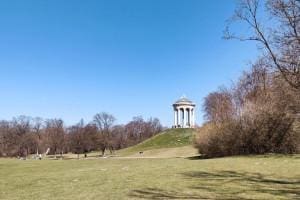The English Garden
Discover with us the idyllic nature and experience active and enjoyable moments in this wonderful city park. The English Garden covers a total area of about 400 hectares and is one of the major inner-city parks worldwide. There are more than 5 million visitors to the park every year. It was created since 1789 – collaterally to the Revolution in Paris – first for military reasons and soon to be opened to the public. By e-bike we cross the English Garden from south to north and of course treat ourselves to a few delicacies in the beer garden in between.


Hofgarten
Court and Finance Gardens (4) of the sovereigns of the state of Bavaria. Both grounds were created at the disposition of the Dukes and later Kings since the 17. Century in the rectangular French style. They are close to the former Munich Residence (1), the largest city palace in Germany. It is open to visitors April-15 October, 9 am-6 pm (last entry: 5 pm). Of special interest are its architecture, room decorations and displays from the former royal collections.
Next door the State Chancellery (1993) is located (3), where the Bavarian head of government resides. It was erected around the central dome of the former Bavarian Army Museum. Before the west side of the courtyard there is a cenotaph, commemorating the victims of both World Wars, and the equestrian statue of Duke Otto I – from the almost sempiternal dynasty of Wittelsbach (1180–1918).
Haus der Kunst
Nearby at the Prinzregentenstraße you may visit the Haus der Kunst (8), a well-established exhibition-center for contemporary art. The monumental building had been constructed in the 1930s as an instrument for Nazi-propaganda and is a perpetual matter of debate for an appropriate arrangement. For nightlife enthusiasts the club P 1 also is incorporated there. Before the Munich Summer Olympics in 1972 a Japanese Teahouse (9) and garden were established on a little island nearby. During the summer there are public ceremonies at weekends.


Eisbach
The water fall was created in 1814-1815 (10) within the Eisbach as a natural looking cascade. Sckell probably was inspired by Dutch landscape paintings. Just at the transition to the City behind the Haus der Kunst You can find the famous River Surfers, practicing at the man made wave at all seasons since the early-1970s. Since a few years, ladies also attend the spot. But risk of injury is severe, hence amateurs and non-locals are not invited to participate actively. Along the lane there is also a second wave of lower grade (12). Generally visitors to the park are urged to avoid any kind of aquatics, although some use to ignore the interdiction.
Monopteros & Chinese Pagoda
The Monopteros (20) is a little temple built in Greek style. It has been renovated – chromatic – unto autumn 2016. The place serves as a popular meeting point and provides a splendid view on park and city. Anyway a direct approach cycling is not allowed, please walk the short distance.
In the middle of the southern, frequented part of the park you find the well known Chinese Pagoda with the appending large beer garden (24). With almost 7.000 seats it is the second largest in Munich. The Pagoda was destroyed during World War II and rebuilt afterwards. The surrounding facilities once were intended as an agricultural model plant, today the administration of the English Garden is situated here. And the wide meadows – e.g. Werneckwiese (29) – all around are used for various kinds of sports and recreation.


Seehaus
At the artificial Kleinhesseloher See (31) there is the beer garden Seehaus (34), where one can relax directly at the waterfront, and a Boat Rental (35) as well. But please don’t trespass the little islands due to the breeding grounds. Here you also can traverse the thruway Isarring (38) into the calm and really near-natural northern part of the park. Close to the Seehaus namely are a pedestrian bridge and an underpass.
Northern part
The northern part of the park is formerly known as “Hirschau”, because it had served as an extensive hunting ground. Therein you also can find several sites of interest, like a dam – where the river can be passed – and a small amphitheatre, which is used for open air performances in summer. Incorporated are the remains of the former “J. A. Maffei” locomotive factory. Several divisions of farming are still practiced. In this part of the English Garden you really might ride your e-bikes out unhindered and aspirate the natural ambience of the park. Further notable beer gardens like Hirschau (49), St. Emmeramsmühle (61) and Aumeister (70) invite you to stay.


Amphitheatre
The amphitheater in the English Garden has existed at various locations in the park since 1793. The open-air stage is currently located on the so-called Siebenbuchenwiese (64), which has been used every summer since 1985. The “Münchner Sommertheater” team stages changing performances there in the middle of the slightly sloping meadow, attracting culture and picnic fans alike. The exact program can be found under the following link.
Isar Weir
Here (59), the Isar is dammed to a height of 6.60 meters and the water is diverted into the Middle Isar Canal. The weir itself is not a hydroelectric power station. However, there is a small, largely underground power station directly below the weir, through which water from the canal is fed back into the Isar. The building belonging to it is the small one behind the fish ladder. It produces 5.7 million kilowatt hours per year. The weir spans a total of 78.50 meters with four arches, each 17 meters wide and around 5.70 meters high. The supporting pillars offer a beautiful vantage point. Up to 150 cubic meters of water can be diverted per second.


